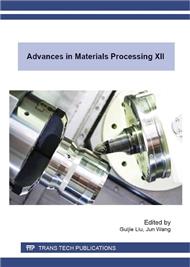[1]
L.R. Ma, J.B. Luo, C.H. Zhang, S.H. Liu, X.C. Lu, D. Guo, J.B. Ma, T. Zhu, Film forming characteristics of oil-in-water emulsion with super-low oil concentration, Colloid Surf. A-Physicochem. Eng. Asp. 340 (2009) 70-76.
DOI: 10.1016/j.colsurfa.2009.03.006
Google Scholar
[2]
A. Cambiella, J.M. Benito, C. Pazos, J. Coca, M. Ratoi, H.A. Spikes, The effect of emulsifier concentration on the lubricating properties of oil-in-water emulsions, Tribol. Lett. 22 (2006) 53-65.
DOI: 10.1007/s11249-006-9072-1
Google Scholar
[3]
Y. Matsubara, T. Hiruta, Y. Kimura, Effect of oil film thickness on lubrication property in hot rolling, ISIJ Int. 55 (2015) 632-636.
DOI: 10.2355/isijinternational.55.632
Google Scholar
[4]
A. Azushima, W.D. Xue, Y. Yoshida, Lubrication mechanism in hot rolling by newly developed simulation testing machine, CIRP Ann-Manuf. Technol. 56 (2007) 297-300.
DOI: 10.1016/j.cirp.2007.05.069
Google Scholar
[5]
A. Azushima, W.D. Xue, Y. Yoshida, Influence of lubricant factors on coefficient of friction and clarification of lubrication mechanism in hot rolling, Tetsu To Hagane-J. Iron Steel Inst. Jpn. 93 (2007) 681-686.
DOI: 10.2355/tetsutohagane.93.681
Google Scholar
[6]
T. Hisakado, T. Tsukizoe, H. Yoshikawa, Lubrication mechanism of solid lubricants in oils. J. Lubr Technol. Trans. ASME. 105 (1983) 245-253.
DOI: 10.1115/1.3254587
Google Scholar
[7]
I. Lahouij, F. Dassenoy, L. de. Knoop, J.M. Martin, B. Vacher, In situ TEM observation of the behavior of an individual fullerene-like MoS2 nanoparticle in a dynamic contact, Tribol Lett. 42 (2011) 133-140.
DOI: 10.1007/s11249-011-9755-0
Google Scholar
[8]
K. Lee, Y. Hwang, S. Cheong, Y. Choi, L Kwon, J. Lee, S.H. Kim, Understanding the role of nanoparticles in nano-oil lubrication, Tribol Lett. 35 (2009) 127-131.
DOI: 10.1007/s11249-009-9441-7
Google Scholar
[9]
T. Young, An essay on the cohesion of fluids, Phil. Trans. R. Soc. 95 (1805) 65-87.
Google Scholar
[10]
T.T. Shi, Y.T. Cai, L. Liu, X.P. Zhou, Formation process of m-ZrO2 nanoparticles by the oil/water interface method combined with seeding technique, Colloid Surf, A-Physicochem. Eng. Asp. 469 (2015) 83-92.
DOI: 10.1016/j.colsurfa.2014.12.034
Google Scholar
[11]
M.W. Shen, J.B. Luo, S.Z. Wen, The tribological properties of oils added with diamond nano-particles, Tribol. Trans. 44 (2001) 494-498.
DOI: 10.1080/10402000108982487
Google Scholar
[12]
G.H. Tang, D.M. Chen, B.Y. Qiu, L. Sheng, Y.H. Wang, G.W. Hu, F.W. Zhao, L.J. Ma, H.A. Wang, Q.Q. Huang, J.J. Xu, C.L. Long, J. Li, Cytotoxic amide alkaloids from piper boehmeriaefolium, J. Nat. Prod. 74 (2011) 45-49.
DOI: 10.1021/np100606u
Google Scholar
[13]
X. Yang, M.W. Shi, L.A. Dong, Y.Y. Ma, G.D. Ye, J.J. Xu, Effect of UV irradiation on mechanical properties and structure of poly(1, 3, 4-oxadiazole) fibers, Polym. Degrad. Stabil. 95 (2010) 2467-2473.
DOI: 10.1016/j.polymdegradstab.2010.08.006
Google Scholar
[14]
S.R. Schmid, W.R.D. Wilson, Lubrication mechanisms for oil-in-water emulsions, Lubr. Eng. 52 (1996) 168-175.
Google Scholar
[15]
L.R. Ma, X.F. Xu, C.H. Zhang, D. Guo, J.B. Luo, Reemulsification effect on the film formation of O/W emulsion, J. Colloid Interf. Sci. 417 (2014) 238-243.
DOI: 10.1016/j.jcis.2013.11.073
Google Scholar
[16]
L.R. Ma, C.H. Zhang, J.B. Luo, Investigation of the film formation mechanism of oil-in-water (O/W) emulsions, Soft Matter. 7 (2011) 4207-4213.
DOI: 10.1039/c0sm01561j
Google Scholar
[17]
J.B. Luo, S.Z. Wen, P. Huang, Thin film lubrication. 1. Study on the transition between EHL and thin film lubrication using a relative optical interference intensity technique, Wear. 194 (1996) 107-115.
DOI: 10.1016/0043-1648(95)06799-x
Google Scholar


